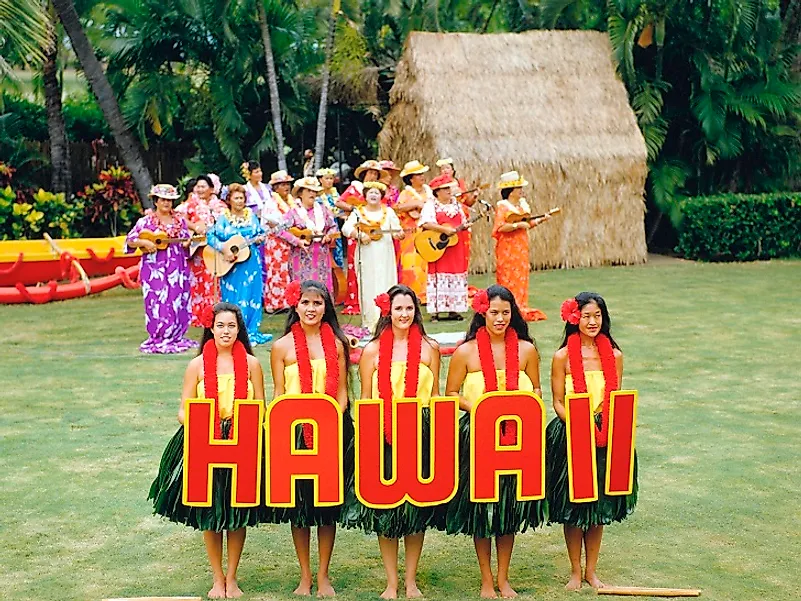Population Of Hawaii

Origin And Growth Of The Population Of Hawaii
Although the origin of the native population of Hawaii is a topic of debate for many scholars, most theories suggest that Polynesian explorers discovered and settled on the islands between 300 and 400 AD. These explorers are believed to have originated from the Marquesas Islands. By 900 AD, human settlements were spread over all of the Hawaiian islands and by 1000 AD, the people were practicing agriculture. Tahitians explorers arrived between 1100 and 1200 AD, conquered the inhabitants, and established a new ruling system. This system separated the islands under different royal lines, brought from Tahiti. This new system promoted the idea of social classes, or castes, that were adhered to for many years. Historians agree that the population grew slowly, moving inland from the coastal regions. By the time European explorers arrived in 1778, the population was between 250,000 and 800,000. European and Asian interest in the islands increased and they began arriving as traders, whalers, and explorers. They brought with them diseases to which the natives had no immunity. By 1820, the native population had been cut in half. During the 1850’s, another 20% was lost to measles. The US Census of 1900 reported 37,656 people of indigenous descent. That number has since grown to around 283,430 people of Pacific Islander or Hawaiian ancestry.
Race And Ethnicity
Today, the population of Hawaii has reached 1,431,603 people who reflect many different races and ethnic identities. These identities, as reported in the 2010 US Census, are Asian (38.6%), White (24.7%), Two or More Races (23.6%), Native Hawaiian or Pacific Islander (10%), Hispanic and Latino (8.9%), Black or African American (1.6%), Other Race (1.2%), Native American or Alaska Native (.3%).
Hawaii is the only state in the US with an Asian majority. Most of these individuals are Filipino Americans and Japanese Americans. There is a smaller population of Chinese Americans and Korean Americans. Of Hispanic and Latino identities, Puerto Ricans and Mexican Americans are the largest groups. Approximately 17.9% of the Hawaiian population was born outside of the US.
Languages Of Hawaii
The official languages of the state are English and Hawaiian. Over 70% of the population speak English at home. Only around 2,000 people speak Hawaiian as their primary native language, although around 24,000 can speak the language. It evolved over time from Polynesian languages belonging to the Austronesian language family. Hawaiians had no alphabet for their language until missionaries in the 1820’s developed a written form based on the Latin alphabet.
Another more common local language is Hawaii Creole English, or Pidgin. This language has around 600,000 native speakers and developed by borrowing from English and various indigenous Hawaiian languages as well as Portuguese, Cantonese, Japanese, Filipino, and Korean. It was a way for English-speaking residents, native Hawaiians, and foreign-born residents to communicate while working together in sugar plantations. Other languages spoken in the state include Tagalog, Japanese, Ilokano, Chinese, and Spanish.
Religion Of The People Of Hawaii
Just over half of the people, 51%, of Hawaii do not practice a religion. They identify as Atheist, Agnostic, or Humanist. The most widely practiced religion on the islands is Christianity, the religion of 29% of the population. Of these Christians, the majority follow the Catholic denomination. Another 9% follow the Buddhism, .8% are Jewish, and 10% are made up of various religions such as Islam, the Baha’i Faith, Hinduism, Taoism, indigenous Hawaiian religions, and Sikhism.
Primary Sources Of Livelihood
Today, the economy relies largely on tourism. This industry is responsible for roughly one-quarter of the gross state product and provides jobs in hotels, restaurants, souvenir shops, surfing shops, and tour agencies. The state also exports agricultural products, including such goods as coffee, pineapples, macadamia nuts, honey, sugarcane, and livestock. Hawaii has a relatively low unemployment rate at 3.2%.
Population Of Hawaii
| Rank | Racial composition | % Of Population (2010) |
|---|---|---|
| 1 | White | 24.7% |
| 2 | Asian | 38.6% |
| 3 | Native Hawaiian and other Pacific Islander | 10.0% |
| 4 | Black | 1.6% |
| 5 | American Indian and Alaskan Native | 0.3% |
| 6 | Other race | 1.2% |
| 7 | Two or more races (Multiracial) | 23.6% |











